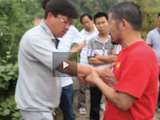About learning
1. Give it enough time. The secret is time.
2. Give yourself enough time to find the shortcuts.
3. Progress comes from holding yourself. Don’t overshoot yourself. Don’t use power.
4. Train the rail – first, you will not get the line. 3-months later, the trajectory is imprinted on the body [with practice]. You’ll see the line.
Theory
1. Incomplete triangle (see triangle illustration in disciple Brian Chung’s notes from the same workshop):
- Layer on multiple triangles to help create triangles in the body. There are many triangles.
- You won’t know when you do it right.
2. Internal / external:
- Internal is when I produce something more than the sum of my body.
- External is when I can map how it should be by looking at it.
3. Seamless:
- The transition has to be seamless (no gap).
- Smooth is seamless but at an advanced level.
4. Distance, angle, accuracy:
- Distance and timing together is acceleration.
- Accuracy can be replaced with “angle”.
5. Peng range is 1/8th of the body part. Too much – too tight. Too little – to0 slack.
6. Power – you don’t feel it when you successfully transmit the power.
Instruction
1. Fetch water – the hand has no energy in it. It’s just a rail. Elbow moves towards the dantian.
2. Muddy / clarity:
- When holding the hand, if the elbow is out and shoulder is out or up then the hand is thick.
- As elbow aligns the hand gets thinner. Then shoulder aligns, the hand gets thinner.
- The hand becomes sharp when elbow and shoulder are aligned. This leads to clarity from muddiness.
3. Exercise – Walk with the tips (point) of the finger pointing to the opponent. Walk towards the opponent and try not to let the opponent see your elbow or shoulder.
4. Taiji walk:
- Never move your knee forward.
- Drop body down onto the heel.
- Knee locks when toes hit the ground.
- Then propel the knee backward.
- Friction with the foot on the floor moves your body forward.
5. When you move a body part you do not involve any other body part.
6. Negative circle – the hand never moves away; it stays on the target. the hand is always focused on the target. You do not become exposed. The finger cannot deviate from the opponent’s nose/throat.
7. When wrestling, always control the kua.
Please also see disciple Brian Chung’s notes from the same workshop.


